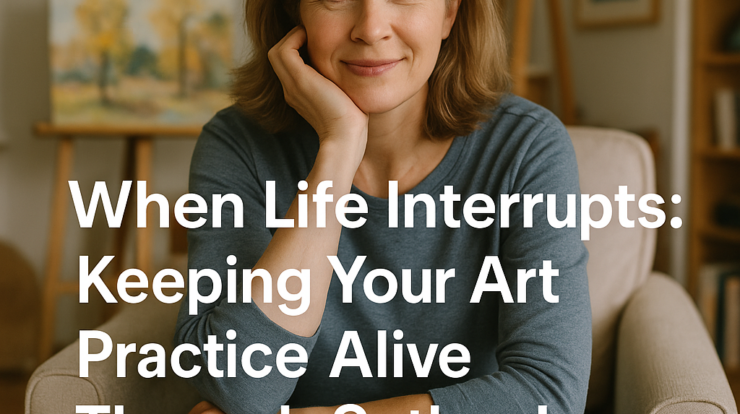
You had a plan.
Maybe it was a show you were preparing for. A new collection in the works. A list of galleries to contact or a goal to paint every day.
And then—something happened.
An illness. An injury. A family member who needed you. A move. A wave of exhaustion you didn’t see coming. Suddenly, everything you were building in your art practice is on hold, and you’re left wondering how (or when) you’ll get back to it.
If this sounds familiar, you’re not alone. It happens to every serious artist at some point. The key is not to avoid these interruptions (you can’t), but to navigate them in a way that protects your creative identity and helps you re-enter when you’re ready.
Here’s how.
1. Pause Without Guilt
This is the most important thing: life comes first. There will be seasons when art takes a back seat. That doesn’t mean you’re not an artist. It means you’re human.

A few years ago, I got sick—really sick. It hit suddenly and laid me up for over a month. I couldn’t get to the gallery. I couldn’t keep up with my usual routine. For a while, I couldn’t do much at all. At first, I felt frustrated. Then I felt guilty—like I was falling behind and letting people down. But looking back, it was a reminder that we don’t control everything. Sometimes the only job is to rest and recover.
Let go of the guilt. Let go of the fear that you’ve lost something permanently. It will come back—and you’ll come back better for it.
2. Stay Connected in Small Ways
Even if you can’t make work, you can still keep a thread tied to your practice:
-
Scroll your old work and remind yourself what you’ve created
-
Take five minutes to jot down an idea or sketch
-
Read something that inspires you
-
Visit a gallery, even briefly
-
Make a list of projects you’ll tackle when the time is right
A creative practice doesn’t disappear—it waits. A spark here and there is enough to keep the connection alive.
3. Keep a “Return Plan” Handy
You may not know when you’ll return to your studio, but having a light framework for how makes re-entry less intimidating. Try this:
“When I’m ready, I’ll…”
-
…start by organizing my space for 30 minutes
-
…finish one small piece, not a full series
-
…reach out to one contact, not five
-
…block out two hours a week to begin, not ten
The first step back doesn’t have to be epic. It just has to happen.
4. Be Honest With Others—And Yourself
If you’ve dropped out of sight, you might feel pressure to explain yourself to collectors, galleries, or peers. You don’t owe anyone an apology—but honesty helps.
Something simple like:
“I’ve been navigating a few things personally, but I’m excited to be back in the studio and creating again.”
That’s enough. People understand. More than you think.
5. Don’t Wait for Everything to Settle
Sometimes the interruption isn’t a short-term thing—it becomes your new normal. Chronic illness. Long-term caregiving. A permanent shift in energy or time.
In those cases, it’s not about returning “when things go back to how they were.” It’s about finding what’s possible now.
-
A slower pace is still progress
-
A reduced output is still art
-
A new routine is still a practice
Make room for creativity as things are, not as you wish they were.
6. Let Setbacks Refine You
Many artists report that after a life interruption, their work deepens. Themes shift. Priorities change. Techniques evolve. The experience shapes what they make—and why.
That’s not a silver lining; it’s a creative truth. Life is the raw material. If you’re going through something hard, it will find its way into the work when the time comes.
And the work will be stronger for it.
Final Thought
You are still an artist, even if your brushes have dust on them. You are still building your career, even if this chapter feels like a detour. You haven’t missed your shot. You’re just taking a breath.
When you’re ready, come back. Start small. Stay kind to yourself. The work will wait.
And it will welcome you back like you never left.
great article and practical, creative ways of staying in touch with your artwork.
Released me from. my self-imposed guilt!
Yes, absolutely correct. When I shared with you, Jason, my setbacks I choose to see as successes…(of sorts), I had no idea really what true success was around the corner. Nor did I know how long things will last. But…I’m holding on to the “little at a time” thought and will head forward. I’m creating in a ever-so-slightly different direction in my art but with only minor differences. It’s the same technique, just different backgrounds. It feels so much mire like “me”. I still am not ready to head full on, but…I DO have my plan in mind. Thanks for your advice.
This is a beautiful and encouraging post. Thank you.